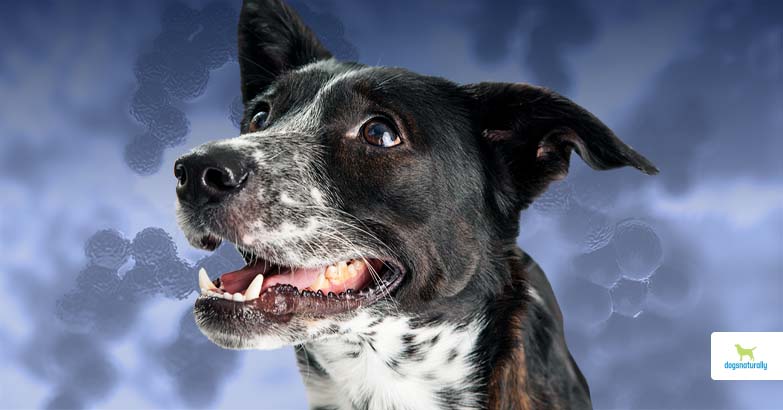Your dog’s skin has its own microbiome where good and bad bacteria coexist … until they get out of balance. So when there’s an open sore or an irritated patch of skin that your dog licks and chews, it can lead to a staph infection in dogs.
Normally, your dog can fight off bacteria with a healthy immune system. But if he’s immune-compromised or stressed, and even if he’s bathed too much, bacteria like Staphylococcus can take hold and become a staph infection.
Here’s what you need to know about staph infections in dogs.
What Is Staph Infection In Dogs?
A staph infection is an inflammatory skin condition caused by the bacteria Staphylococcus. This bacteria lives freely in the environment on various surfaces and personal items so both dogs and people can pick it up through a cut or irritation in the skin. Pus from an abscess can be immediately contagious on the skin through a cut. The bacteria enters and if the immune system isn’t able to fight it, it can take hold and cause an infection. Staphylococcus can also infect your dog’s upper respiratory tract.
Is Dog Staph Infection Contagious?
Staph infections in dogs and cats are not usually contagious to people. There are some cases where staph can be transferred from a pet to a person, but lots of hand washing can avoid any transmission. Staph infections aren’t usually contagious to other dogs, but the bacteria can be transferred to other animals through bites and scratches.
Can Staph Infection Kill A Dog?
Yes, it can. If left untreated, serious staph infections can lead to septicemia (blood poisoning) and death.
What Causes Staph Infection In Dogs?
Staphylococcus lives naturally on the skin. An infection can occur if the skin is damaged or there is an underlying medical condition. When dogs excessively lick, scratch or chew until the skin becomes irritated, it provides access for staph to enter the body. Staph infections often occur in dogs who have fleas or allergies that lead to lots of itching and scratching.
Your dog can get a staph infection anywhere on his body … like between his toes or his legs. Staph infection on a dog’s stomach can occur from having an open sore and coming into contact with staph in the environment.
Staph infections can happen in any dog regardless of breed or age, but they are more common in younger pets with immature immune systems, and older dogs with weaker immune systems.
If your dog has a bacterial or fungal infection of the blood, a chronic disease that wears down the immune system, allergies, or other secondary infections, he is more susceptible to a staph infection.
Symptoms Of Staph Infection In Dogs
While skin irritations are common in dogs, here are some signs that it might be a staph infection.
- Excessive itching, chewing or licking
- Inflamed skin with red bumps/pimples (papules)
- Pus-filled pustules
- Pus at the wound site
- Crusting of the wound and surrounding skin.
- Round areas with a dark center and red crusty border
- Crusty or scaly areas
- Redness and sensitivity
- Fur loss, and fur that comes out in clumps
- Loss of appetite
- Fatigue
- Infections of the eyes, skin, ears or respiratory system
How To Diagnose Staph Infection In Dogs
As noted, there are many things that cause itching in dogs. A staph infection is caused by bacteria so it isn’t something you can diagnose on your own. If the symptoms suggest a staph infection, your vet can do some testing to confirm it.
Vets can conduct a biochemistry profile, a urinalysis, blood tests, and a skin test to determine if allergies or immune-related issues are causing the inflammation. In severe cases, they can do a skin biopsy and a skin swab.
Traditional Treatment For Staph Infection In Dogs
The traditional veterinary approach is to prescribe antibiotics appropriate for the Staphylococcus bacteria. But since staph infections take hold when the immune system is weak, antibiotics will do more harm to your dog’s immune system while not solving the problem. And now, more and more bacteria like staph are becoming antibiotic resistant so stronger and stronger drugs are being used, and they’re often ineffective. They destroy the beneficial bacteria in your dog’s gut where 90% of his immune system exists while leaving the staph to thrive.
Other suggested treatments include bathing your dog with an antibacterial shampoo or applying topical appointments. But any “anti” topical treatments can suppress the disease and drive it deeper. In that case it can come back, often in a worse form. And your dog’s skin has a microbiome, so medicated shampoos or treatments can disrupt the good bacteria, and again, lead to a worse problem in future. If you need to bathe your dog to relieve itching, it’s safest to use an organic, natural shampoo that won’t destroy beneficial bacteria on your dog’s skin.
RELATED: Learn more about antibiotic resistance in dogs …
Natural Treatment For Staph Infection In Dogs
As noted earlier, you want to avoid cross-contamination so good hygiene is a must. Be diligent with hand-washing, and keep your dog’s bedding, toys and bowls clean.
Dog Staph Infection Home Remedy
Natural antibiotic remedies will support your dog’s health in other ways while treating a staph infection. You may need to use these natural options for several weeks to make sure the infection is resolved.
Topical Remedies
These remedies can be applied directly to the infected area daily or as needed.
Manuka Honey
Research shows Manuka honey can clear up MRSA and other antibiotic-resistant “superbug” infections. You can warm it and drip it directly onto the area.
Calendula
It has antibacterial, antiviral, and antifungal properties to disinfect and heal wounds. Make a tea of 2 tsp of dried calendula leaves, cool, strain and then apply it as a spray. It stimulates the liver and immune system when taken internally as a tea or tincture. Use it as a tincture and add several drops to each meal.
Yarrow
It has antibacterial, anti-inflammatory, and antiseptic properties. Use it externally as a tincture and apply a few drops directly to stop bleeding and infections.
Turmeric
Known to be anti-bacterial, anti-inflammatory, and a powerful antioxidant. Mix powdered turmeric with Manuka honey (another natural antibiotic) and apply it directly.
Echinacea
Echinacea has anti-bacterial and anti-inflammatory properties. Apply a few drops directly as a tincture or make a tea from dried leaves to spray on the infected area.
Propolis
In liquid form, it can be applied to burns and minor wounds, and can be soothing when a few drops are mixed with aloe vera gel.
Oatmeal
Oatmeal calms itching, soothes irritation, fights dryness and reduces skin sensitivity. Make a paste using ¼ cup of powdered organic oatmeal, adding enough water to get a spreadable consistency, and apply to the infected area.
Concentrated Heat
Hold a hot water bottle on the affected area, to relax blood vessels to reduce inflammation and pain. Test the temperature on your own skin to make sure it’s not too hot for your dog.
Oral Remedies
These are oral remedies to help fight the infection from within.
Oil Of Oregano
It’s antibacterial, antiviral and antiparasitic to eliminate microbes and bacteria. Oil of oregano is powerful so should never be used undiluted. Add 2-3 drops to a teaspoon of almond oil or MCT oil, 3 times a day, or mix with a bit of food. For topical use, mix 1 drop of oregano with 1 tsp of almond oil.
Garlic
It’s antimicrobial and antibacterial to combat bacteria and fungi. Crush a clove of garlic and add it to your dog’s food. Feed it based on your dog’s weight:
- 5 lbs … ⅙ tsp
- 10 lbs … ⅓ tsp
- 15 lbs … ½ tsp
- 20 lbs … ⅔ tsp
- 20 lbs … 1 tsp
Don’t give garlic to pregnant dogs or puppies under 6 months old. If your dog is on medications, check with your vet first.
Culinary Herbs
Thyme, basil, pepper and ginger have antibacterial properties. Add a pinch or 2 to your dog’s meal.
Omega 3 Fatty Acids
These essential fatty acids support metabolism, allergies and fight inflammation. Follow dosing on the product packaging.
How to Prevent Staph Infection In Dogs
Traditional medicine will say there are no known preventive measures for staph infection. And yet traditional medicine also says it’s a weak immune system in younger and older dogs that makes them more susceptible to staph infection.
The best natural way to prevent staph infection is to support the immune system. Here’s what you can do to strengthen your dog’s immune system to avoid a staph infection … and build overall good health.
Remove Allergens
Dogs with allergies are at a higher risk for staph infections because of constant itching and scratching that causes irritated skin and open wounds. Use non-toxic cleaning products at home and avoid taking your dog to public areas where there’s high pesticide use that might affect him. If your dog has food sensitivities, start by feeding a single protein you know he tolerates, and slowly add new foods to ensure he doesn’t react.
Feed A Whole Food Diet
Avoid processed foods that have added synthetic ingredients and supplements. If you’re feeding a whole food diet your dog is getting antioxidants and all the nutrients he needs from his food, not chemicals. When your dog’s getting proper nutrition, you’re supporting his immune system and he’s less likely to develop health conditions or diseases.
Feed Probiotics
Probiotics provide the beneficial bacteria in your dog’s gut where about 90% of his immune system lives. Probiotics can help crowd out pathogenic bacteria.
Treat Injuries Quickly
This extends beyond handwashing. If your dog is injured, treat the wound right away and try to keep it covered. You want the wound to heal on its own and if your dog has a healthy immune system, it will.
Avoid Antibiotics And Medications
Antibiotics and medications can harm your dog’s gut and skin health by destroying good bacteria. And like the immune system in his gut, the microbiome of your dog’s skin is its first line of defense. Skin, eye, ear and gut health can be compromised by medications that destroy both good and bad bacteria. Beneficial bacteria help keep infection-causing bacteria at bay.
As in all things dog, a healthy immune system is the key to your dog’s good health and helps prevent nasty things like a staph infection. And even if illness does step in, having strong immunity helps lead to a quick recovery.
References:
- Jenkins R, Burton N, Cooper R. Manuka honey inhibits cell division in methicillin-resistant Staphylococcus aureus. J Antimicrob Chemother. 2011 Nov;66(11):2536-42.
- Priyantha R, Gaunt MC, Rubin JE. Antimicrobial susceptibility of Staphylococcus pseudintermedius colonizing healthy dogs in Saskatoon, Canada. Can Vet J. 2016 Jan;57(1):65-9.
- Ruzauskas M, Couto N, et al. Prevalence, species distribution and antimicrobial resistance patterns of methicillin-resistant staphylococci in Lithuanian pet animals. Acta Vet Scand. 2015 Jun 2;57(1):27.
- Norström M, Sunde M, et al. Antimicrobial resistance in Staphylococcus pseudintermedius in the Norwegian dog population. Microb Drug Resist. 2009 Mar;15(1):55-9.












